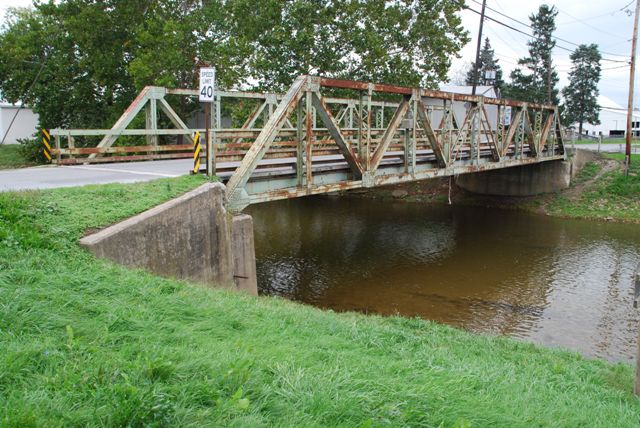We Recommend:
Bach Steel - Experts at historic truss bridge restoration.
White Oak Road Bridge

Primary Photographer(s): Elaine Deutsch
Bridge Documented: September 30, 2011
Rural: Lancaster County, Pennsylvania: United States
Not Available or Not Applicable
102.0 Feet (31.1 Meters)
103.0 Feet (31.4 Meters)
20 Feet (6.1 Meters)
1 Main Span(s)
36720908100304

View Information About HSR Ratings
Bridge Documentation
View Archived National Bridge Inventory Report - Has Additional Details and Evaluation
This bridge is a somewhat late example of a metal truss highway bridge in Pennsylvania. Most truss bridges being built by the 1930s were built to a state standard plan. This bridge does not appear to conform to a state standard plan, however, and instead appears to be a county-designed bridge. This is not the only example of this style and vintage truss in Lancaster County, further evidence that this was a county design.
Lancaster County is unusual because it has far more covered bridges (all preserved) than metal truss bridges, even though covered bridges are from an older era, and are not built of materials that are more durable than a metal truss bridge. The rust on this truss indicates that a preservation commitment is not in place for this bridge. The outdated "not historic" finding for this bridge by the Historic Bridge Inventory needs to be rejected, and this historic bridge should be restored and preserved just like the dozens of covered bridges in this county.
Information and Findings From Pennsylvania's Historic Bridge InventoryDiscussion of Bridge The single span, 103'-long, rivet-connected Warren with verticals pony truss bridge built in 1937 is supported on concrete abutments with flared wingwalls. The truss members are builtup of standard steel sections. Channel railings are set to the inside faces of the trusses. The bridge has been altered by plate welded to the lower chords, upper chords, diagonals, inclined end posts, and gusset plates (ca. 1970). The Warren truss design emerged as one of the most commonly used truss designs after 1895 because of advances in metallurgy and the mid-1890s improvements to field pneumatic riveting. The result was a rapid shift from pinned to riveted connections and the Warren design was particularly well suited for rigid connections. Over 125 examples of the type/design have been identified in the state from the late 1890s to 1956. This late example has no noteworthy features or details. It has been altered by welded repairs. The bridge is not historically or technologically distinguished by its setting or context. Discussion of Surrounding Area The bridge carries a 2 lane road over a stream in a rural setting of active farms. At the northwest and southeast quadrants are modern agricultural processing plants in pole barns. At the southwest quadrant is pallet storage. A 19th century vernacular farmhouse is at the northeast quadrant. The setting does not have the cohesiveness or integrity of a historic district. Bridge Considered Historic By Survey: Yes |
![]()
Photo Galleries and Videos: White Oak Road Bridge
Bridge Photo-Documentation
Original / Full Size PhotosA collection of overview and detail photos. This gallery offers photos in the highest available resolution and file size in a touch-friendly popup viewer.
Alternatively, Browse Without Using Viewer
![]()
Bridge Photo-Documentation
Mobile Optimized PhotosA collection of overview and detail photos. This gallery features data-friendly, fast-loading photos in a touch-friendly popup viewer.
Alternatively, Browse Without Using Viewer
![]()
Maps and Links: White Oak Road Bridge
Coordinates (Latitude, Longitude):
Search For Additional Bridge Listings:
Bridgehunter.com: View listed bridges within 0.5 miles (0.8 kilometers) of this bridge.
Bridgehunter.com: View listed bridges within 10 miles (16 kilometers) of this bridge.
Additional Maps:
Google Streetview (If Available)
GeoHack (Additional Links and Coordinates)
Apple Maps (Via DuckDuckGo Search)
Apple Maps (Apple devices only)
Android: Open Location In Your Map or GPS App
Flickr Gallery (Find Nearby Photos)
Wikimedia Commons (Find Nearby Photos)
Directions Via Sygic For Android
Directions Via Sygic For iOS and Android Dolphin Browser
USGS National Map (United States Only)
Historical USGS Topo Maps (United States Only)
Historic Aerials (United States Only)
CalTopo Maps (United States Only)

